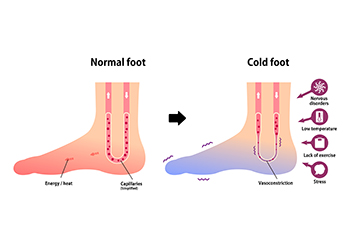Items filtered by date: March 2024
Causes of Chronic Cold Feet

Finding the cause of cold feet is important for both comfort and overall health. While environmental factors may contribute to occasional coldness in the extremities, persistent cold feet could indicate underlying issues. One major issue is poor circulation, often linked to heart conditions, sedentary lifestyles, or smoking. Iron-deficiency anemia is another common cause of cold feet, necessitating dietary changes and supplementation. Diabetes, particularly types 1 and 2, can lead to cold feet from nerve damage, underscoring the importance of blood sugar management. Further, hypothyroidism, peripheral vascular disease, Raynaud’s phenomenon, and arteriosclerosis can all contribute to cold feet. If you are experiencing recurrent cold feet or associated symptoms, like numbness or tingling, it's suggested that you make an appointment with a podiatrist for an evaluation, diagnosis, and treatment options.
While poor circulation itself isn’t a condition; it is a symptom of another underlying health condition you may have. If you have any concerns with poor circulation in your feet contact one of our podiatrists of Ankle & Foot Care Center. Our doctors will treat your foot and ankle needs.
Poor Circulation in the Feet
Peripheral artery disease (PAD) can potentially lead to poor circulation in the lower extremities. PAD is a condition that causes the blood vessels and arteries to narrow. In a linked condition called atherosclerosis, the arteries stiffen up due to a buildup of plaque in the arteries and blood vessels. These two conditions can cause a decrease in the amount of blood that flows to your extremities, therefore resulting in pain.
Symptoms
Some of the most common symptoms of poor circulation are:
- Numbness
- Tingling
- Throbbing or stinging pain in limbs
- Pain
- Muscle Cramps
Treatment for poor circulation often depends on the underlying condition that causes it. Methods for treatment may include insulin for diabetes, special exercise programs, surgery for varicose veins, or compression socks for swollen legs.
As always, see a podiatrist as he or she will assist in finding a regimen that suits you. A podiatrist can also prescribe you any needed medication.
If you have any questions, please feel free to contact our office located in Jupiter, FL . We offer the newest diagnostic and treatment technologies for all your foot care needs.
Staying Abreast of Diabetic Foot Ulcer Treatments

Staying informed about diabetic foot ulcer treatments is necessary for effective patient care. Common interventions include surgical debridement to remove necrotic tissue, antibiotic therapy to combat infection, and vascular assessment to optimize blood flow. Offloading pressure from affected areas is essential for healing. In severe cases, amputation may be necessary to prevent further complications. Additionally, various therapies exist for non-healing wounds, such as advanced dressing. Podiatrists play a vital role in diabetic foot ulcer management, possessing specialized education and skills in this field. By staying abreast of evolving treatments and leveraging multidisciplinary approaches, they can enhance outcomes and improve the quality of life for individuals with diabetic foot ulcers. If you suffer from diabetic foot ulcers, it is strongly suggested that you make routine appointments with a podiatrist for the best care possible.
Wound care is an important part in dealing with diabetes. If you have diabetes and a foot wound or would like more information about wound care for diabetics, consult with one of our podiatrists from Ankle & Foot Care Center. Our doctors will assess your condition and provide you with quality foot and ankle treatment.
What Is Wound Care?
Wound care is the practice of taking proper care of a wound. This can range from the smallest to the largest of wounds. While everyone can benefit from proper wound care, it is much more important for diabetics. Diabetics often suffer from poor blood circulation which causes wounds to heal much slower than they would in a non-diabetic.
What Is the Importance of Wound Care?
While it may not seem apparent with small ulcers on the foot, for diabetics, any size ulcer can become infected. Diabetics often also suffer from neuropathy, or nerve loss. This means they might not even feel when they have an ulcer on their foot. If the wound becomes severely infected, amputation may be necessary. Therefore, it is of the upmost importance to properly care for any and all foot wounds.
How to Care for Wounds
The best way to care for foot wounds is to prevent them. For diabetics, this means daily inspections of the feet for any signs of abnormalities or ulcers. It is also recommended to see a podiatrist several times a year for a foot inspection. If you do have an ulcer, run the wound under water to clear dirt from the wound; then apply antibiotic ointment to the wound and cover with a bandage. Bandages should be changed daily and keeping pressure off the wound is smart. It is advised to see a podiatrist, who can keep an eye on it.
If you have any questions, please feel free to contact our office located in Jupiter, FL . We offer the newest diagnostic and treatment technologies for all your foot care needs.
Dealing With an Ankle Sprain

Ankle sprains occur when the ligaments in your ankle are stretched or torn beyond their intended limits, leading to varying degrees of pain and swelling. Ankle sprains are typically categorized into three grades, ranging from mild stretching to full tearing of ligaments, with Grade III sprains often requiring medical intervention, such as a brace or in some cases, surgery. While certain self-care measures help to ease symptoms, seeking expert care from a podiatrist is essential for a proper diagnosis, treatment, and prevention of chronic ankle sprains. A podiatrist may recommend using splints, casts, or braces, along with rehab exercises to aid in recovery and prevent future sprains. It is especially important to monitor symptoms closely and seek medical attention if pain persists or worsens, or if there are signs of numbness, weakness, or other concerning symptoms. With proper care and guidance from a podiatrist, most ankle sprains can heal effectively. If you have a sprained ankle, it is suggested that you seek immediate attention from a podiatrist who is trained to deal with this injury.
Although ankle sprains are common, they aren’t always minor injuries. If you need your ankle injury looked at, contact one of our podiatrists from Ankle & Foot Care Center. Our doctors can provide the care you need to keep you pain-free and on your feet.
How Does an Ankle Sprain Occur?
Ankle sprains are the result of a tear in the ligaments within the ankle. These injuries may happen when you make a rapid shifting movement while your foot is planted. A less common way to sprain your ankle is when your ankle rolls inward while your foot turns outward.
What Are the Symptoms?
- Pain at the sight of the tear
- Bruising/Swelling
- Ankle area is tender to touch
- In severe cases, may hear/feel something tear
- Skin discoloration
Preventing a Sprain
- Wearing appropriate shoes for the occasion
- Stretching before exercises and sports
- Knowing your limits
Treatment of a Sprain
In many cases, the RICE method (Rest, Ice, Compression, and Elevate) is used to treat ankle sprains. However, you should see a podiatrist to see which treatment option would work best with your injury. In severe cases, surgery may be required.
It is important to ask your doctor about rehab options after you receive treatment for your injury. Stretching, strength training, and balance exercises may help the ankle heal while also preventing further injury.
If you have any questions, please feel free to contact our office located in Jupiter, FL . We offer the newest diagnostic and treatment technologies for all your foot care needs.
Heel Pain From Bursitis

Heel pain can be caused by bursitis, which is a painful swelling of the small fluid-filled sacs called bursae. These bursae act as cushions, reducing friction between tissues such as tendons, ligaments, and bones. When they become inflamed, the result is heel pain and limited mobility, particularly in areas like the back or bottom of the heel. Bursitis typically develops due to repetitive movements or prolonged pressure on a joint. Aging also can lead to the breakdown of the bursa over time. Symptoms often include dull pain, tenderness, and stiffness near the affected area. Swelling and redness may also be present, indicating inflammation. Diagnosing bursitis involves a thorough examination by a podiatrist. After a physical examination of the affected area, further tests such as X-rays, MRI scans, or ultrasound may be necessary. If you are experiencing unexplained heel pain, it is suggested that you schedule an appointment with a podiatrist who can determine if you may be suffering from bursitis.
Many people suffer from bouts of heel pain. For more information, contact one of our podiatrists of Ankle & Foot Care Center. Our doctors can provide the care you need to keep you pain-free and on your feet.
Causes of Heel Pain
Heel pain is often associated with plantar fasciitis. The plantar fascia is a band of tissues that extends along the bottom of the foot. A rip or tear in this ligament can cause inflammation of the tissue.
Achilles tendonitis is another cause of heel pain. Inflammation of the Achilles tendon will cause pain from fractures and muscle tearing. Lack of flexibility is also another symptom.
Heel spurs are another cause of pain. When the tissues of the plantar fascia undergo a great deal of stress, it can lead to ligament separation from the heel bone, causing heel spurs.
Why Might Heel Pain Occur?
- Wearing ill-fitting shoes
- Wearing non-supportive shoes
- Weight change
- Excessive running
Treatments
Heel pain should be treated as soon as possible for immediate results. Keeping your feet in a stress-free environment will help. If you suffer from Achilles tendonitis or plantar fasciitis, applying ice will reduce the swelling. Stretching before an exercise like running will help the muscles. Using all these tips will help make heel pain a condition of the past.
If you have any questions please contact our office located in Jupiter, FL . We offer the newest diagnostic and treatment technologies for all your foot and ankle needs.

